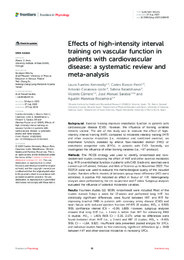Please use this identifier to cite or link to this item:
https://hdl.handle.net/11000/30769Full metadata record
| DC Field | Value | Language |
|---|---|---|
| dc.contributor.author | Fuertes kenneally, Laura | - |
| dc.contributor.author | Blasco Peris, Carles Andreu | - |
| dc.contributor.author | Casanova-Lizón, Antonio | - |
| dc.contributor.author | Baladzhaeva, Sabina | - |
| dc.contributor.author | Climent, Vicente | - |
| dc.contributor.author | Sarabia, José M. | - |
| dc.contributor.author | Manresa Rocamora, Agustin | - |
| dc.contributor.other | Departamentos de la UMH::Ciencias del Deporte | es_ES |
| dc.date.accessioned | 2024-01-26T12:49:17Z | - |
| dc.date.available | 2024-01-26T12:49:17Z | - |
| dc.date.created | 2023-07-17 | - |
| dc.identifier.citation | Frontiers in Physiology 2023; 14: 1196665 | es_ES |
| dc.identifier.issn | 1664-042X | - |
| dc.identifier.uri | https://hdl.handle.net/11000/30769 | - |
| dc.description.abstract | Background: Exercise training improves endothelial function in patients with cardiovascular disease (CVD). However, the influence of training variables remains unclear. The aim of this study was to evaluate the effect of highintensity interval training (HIIT), compared to moderate intensity training (MIT) and other exercise modalities (i.e., resistance and combined exercise), on endothelial function, assessed by arterial flow-mediated dilation (FMD) or endothelial progenitor cells (EPCs), in patients with CVD. Secondly, we investigated the influence of other training variables (i.e., HIIT protocol). Methods: The PICOS strategy was used to identify randomised and nonrandomised studies comparing the effect of HIIT and other exercise modalities (e.g., MIT) on endothelial function in patients with CVD. Electronic searches were carried out in Pubmed, Embase, and Web of Science up to November 2022. The TESTEX scale was used to evaluate the methodological quality of the included studies. Random-effects models of between-group mean difference (MD) were estimated. A positive MD indicated an effect in favour of HIIT. Heterogeneity analyses were performed by the chi-square test and I2 index. Subgroup analyses evaluated the influence of potential moderator variables. Results: Fourteen studies (13; 92.9% randomised) were included. Most of the studies trained 3 days a week for 12 weeks and performed long HIIT. No statistically significant differences were found between HIIT and MIT for improving brachial FMD in patients with coronary artery disease (CAD) and heart failure with reduced ejection fraction (HFrEF) (8 studies; MD+ = 0.91% [95% confidence interval (CI) = −0.06, 1.88]). However, subgroup analyses showed that long HIIT (i.e., > 1 min) is better than MIT for enhancing FMD (5 studies; MD+ = 1.46% [95% CI = 0.35, 2.57]), while no differences were found between short HIIT (i.e., ≤ 1 min) and MIT (3 studies; MD+ = −0.41% [95% CI = −1.64, 0.82]). Insufficient data prevented pooled analysis for EPCs, and individual studies failed to find statistically significant differences (p > .050) between HIIT and other exercise modalities in increasing EPCs. Discussion: Poor methodological quality could limit the precision of the current results and increase the inconsistency. Long HIIT is superior to MIT for improving FMD in patients with CAD or HFrEF. Future studies comparing HIIT to other exercise modalities, as well as the effect on EPCs and in HF with preserved ejection fraction are required. | es_ES |
| dc.format | application/pdf | es_ES |
| dc.format.extent | 15 | es_ES |
| dc.language.iso | eng | es_ES |
| dc.publisher | Frontiers Media | es_ES |
| dc.rights | info:eu-repo/semantics/openAccess | es_ES |
| dc.rights | Attribution-NonCommercial-NoDerivatives 4.0 Internacional | * |
| dc.rights.uri | http://creativecommons.org/licenses/by-nc-nd/4.0/ | * |
| dc.subject | high-intensity interval training | es_ES |
| dc.subject | vascular function | es_ES |
| dc.subject | cardiovascular disease | es_ES |
| dc.subject | training variables | es_ES |
| dc.subject | flow-mediated dilation | es_ES |
| dc.subject | endothelial progenitor cells | es_ES |
| dc.subject | coronary artery disease | es_ES |
| dc.subject | heart failure | es_ES |
| dc.subject.classification | Educación Física y Deportiva | es_ES |
| dc.subject.other | CDU::796 - Juegos.Deportes | es_ES |
| dc.title | Effects of high-intensity interval training on vascular function in patients with cardiovascular disease: a systematic review and meta-analysis | es_ES |
| dc.type | info:eu-repo/semantics/article | es_ES |
| dc.relation.publisherversion | https://doi.org/10.3389/fphys.2023.1196665 | es_ES |

View/Open:
2023 Fuertes - Effectos of HIIT on vascular function in CVD.pdf
1,35 MB
Adobe PDF
Share:
.png)
